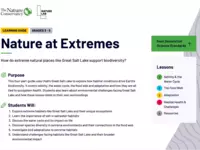https://www.nature.org/content/dam/tnc/nature/en/documents/nature-lab-lesson-plans/Nature_Lab_Nature_at_Extremes.pdf
The Nature Conservency
This series of five learning activities each take 40 minutes.
Learn more about Teaching Climate Literacy and Energy Awareness»Grade Level
Regional Focus
Online Readiness
Topics
Climate Literacy
This Activity builds on the following concepts of Climate Literacy.
Click a topic below for supporting information, teaching ideas, and sample activities.
Energy Literacy
This Activity builds on the following concepts of Energy Literacy.
Click a topic below for supporting information, teaching ideas, and sample activities.
Notes From Our Reviewers
The CLEAN collection is hand-picked and rigorously reviewed for scientific accuracy and classroom effectiveness.
Read what our review team had to say about this resource below or learn more about
how CLEAN reviews teaching materials
Teaching Tips | Science | Pedagogy |
Technical Details
Teaching Tips
- Ideally, this resource would be used in Utah or near the Great Salt Lake so a field trip could be taken.
- As an extension, the lesson could look at local water sources (where the lesson is taught). Even in areas where only freshwater exists, some of the themes could be expanded/modified to make a closer connection with their local ecosystems (birds of the area for example).
- The Nature Conservancy works across all 50 states, so looking at the TNC page for respective states might be useful for additional resources.
- Might put virtual field trip at beginning of activity to help students resonate with the location before starting the activities.
About the Content
- This resource incorporates four science-themed activities: 1) Creating condensation (with water and jar), 2) Wear the water cycle (by making a bracelet and seeing how salt dissolves in a bowl), 3) Food web and adaptation (coloring activity and making a bird feeder, trying out different types of beaks), and 4) Habitat health challenges – water bingo. Through these activities, students can learn in a fun and engaging way which requires full class participation.
- Background materials are listed for each topic and are useful, succinct, and easy to read. Science is accurate and there are multiple one-lesson activities for each topic.
- Passed initial science review - expert science review pending.
About the Pedagogy
- This resource appeals most to hands-on learners or kinesthetic learners as it involves several activities of varying lengths through art projects, games, and science projects.
- Each lesson can be taught as a one-off, but lessons scaffold well together to discuss biodiversity. Teaching guidelines are clear and easy to follow.
- This resource engages students in using scientific data.
See other data-rich activities








